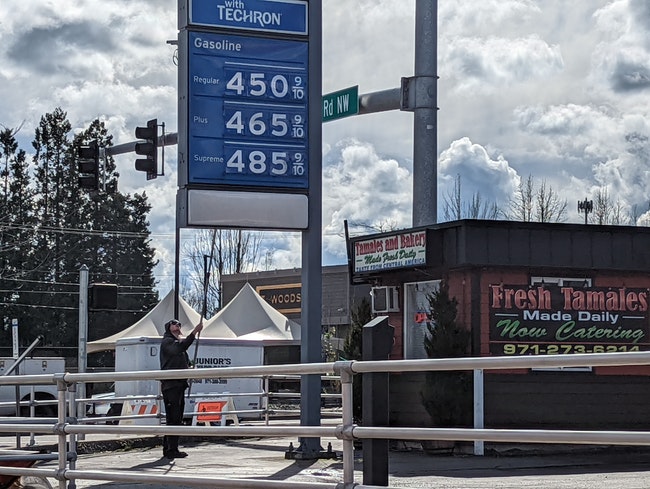 A worker at a west Salem gas station changes prices on a readerboard on March 4 as fuel prices spiked across the world. (Rachel Alexander/Salem Reporter)
A worker at a west Salem gas station changes prices on a readerboard on March 4 as fuel prices spiked across the world. (Rachel Alexander/Salem Reporter)
It takes Salem’s school bus drivers more than 1,000 gallons of diesel and 500 gallons of gasoline to transport tens of thousands of kids to and from school every day.
With gas prices spiking around the U.S., the cost of the district’s average fuel order is nearly double what it was last March – with most of that increase happening in the past few weeks.
A March 14 fuel order, enough to run the Salem-Keizer bus fleet for about a week, cost just over $32,000, said Mitchell Hamilton, the district’s transportation operations manager.
Last March, the same order was about $18,000. Hamilton said prices have risen steadily over the past year, but spiked dramatically when the Russian invasion of Ukraine started and President Joe Biden signed an executive order March 8 banning Russian oil imports.
“Gradual increase over the school year wouldn’t wouldn’t necessarily be a huge concern. It’s this recent spike that your invoices almost double, that’s concerning,” Hamilton said.
As Oregonians continue to see fuel costs spike, transportation, law enforcement and public works agencies across the Salem area are also paying more at the pump. Those who pay contracted fuel prices and haven’t yet seen an increase say they expect to pay more at the end of their budgeted term.
Most agencies said they can weather a temporary increase, and some have so far been insulated by contracts which have kept prices lower. But as agencies approach budget season and plan for major public works projects over the summer, managers are concerned about the impact of high fuel costs.
Salem’s mass transit agency is spending more than double its per-gallon budget for diesel fuel.
Allan Pollock, Cherriots’ general manager and CEO, said prices have steadily increased since a January 2021 low of $1.41 per gallon.
The agency budgeted $1.78 per gallon for the fiscal year July to June. On March 16, they were paying $4.10 per gallon.
Pollock said they expect to stay within their budget of about $359,000 for diesel fuel.
Of their 64 buses, 34 run on compressed natural gas, which have not seen the same price spikes. He said they will look at running the compressed natural gas fleet more, particularly on weekends when fewer buses are needed each day, but they try to rotate buses to spread out miles evenly across the fleet.
Cherriots is also starting some routes later than normal and ending others due to staff shortages, resulting in lower fuel costs.
“We’re right in budget season now, so we’ll be looking at that. We’ll probably budget a little higher,” he said.
The Oregon Department of Education reimburses local school districts for 70% of transportation expenses, which lifts some of the burden on Salem-Keizer.
Hamilton said a brief spike in costs is within the district’s ability to manage.
“Right now, the spike is late enough in the year that as long as it plateaus out at this point, we should be okay as long as it doesn’t keep increasing,” he said.
But prolonged high fuel prices will affect transportation budgeting for the upcoming school year, he said.
If fuel trends continue, Marion County officials expect fuel costs to go up about $200,000 for Public Works Department vehicles in 2022, said county spokeswoman Yancee Gordon.
The department budgeted around $117,500 for gasoline and $232,000 for diesel for the 2021-22 fiscal year, the county’s budget showed.
Gordon said they will adjust some work to accommodate the price spikes but don’t expect any significant changes to the amount of work operations and maintenance staff complete.
She also said the state Department of Transportation recently estimated a 20% cost increase for liquid asphalt in 2022.
“We do most of our paving and resurfacing during the summer, so we have been taking these increases into account as we plan summer projects,” she said in an email.
The city of Salem buys fuel wholesale and can keep prices charged to departments the same throughout its budget year ending July 1. At that point, city officials expect the Public Works Department’s price will increase, said city spokeswoman Courtney Knox-Busch.
The city’s wholesale fuel costs are still within budget for the fiscal year, she said in an email.
The Salem Police Department also gets gas in bulk and isn’t yet paying more, but spokeswoman Lt. Debbie Aguilar said they expect that to change as their suppliers start to pay more.
“We are always reminding our officers about fuel saving measures like not keeping their car idling when they are out on a call. If the price continues to rise then we can look at how else can we save gas, but knowing we have to be able to drive to calls for service and be proactive and present in the community,” Aguilar said in an email.
Sgt. Jeremy Landers, spokesman for the Marion County Sheriff’s Office, said the agency has also seen a rise in fuel costs but hasn’t had to cut back on its operations.
Correction: This story was updated to reflect that Cherriots is reducing its service levels because of staff shortages. Salem Reporter regrets the error.
Contact reporter Ardeshir Tabrizian: [email protected] or 503-929-3053. Contact reporter Rachel Alexander: [email protected] or 503-575-1241.
JUST THE FACTS, FOR SALEM – We report on your community with care and depth, fairness and accuracy. Get local news that matters to you. Subscribe to Salem Reporter starting at $5 a month. Click I want to subscribe!









